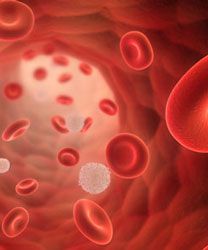PFS Not Improved With Frontline Lenalidomide/R-CHOP Combo in DLBCL
Combining lenalidomide with rituximab, cyclophosphamide, doxorubicin, vincristine, and prednisone did not improve progression-free survival compared with placebo and R-CHOP as a frontline therapy in patients with activated B-cell-type diffuse large B-cell lymphoma, missing the primary endpoint of the phase III ROBUST trial.

Combining lenalidomide (Revlimid) with rituximab (Rituxan), cyclophosphamide, doxorubicin, vincristine, and prednisone (R-CHOP; R2-CHOP) did not improve progression-free survival (PFS) compared with placebo and R-CHOP as a frontline therapy in patients with activated B-cell (ABC)-type diffuse large B-cell lymphoma (DLBCL), missing the primary endpoint of the phase III ROBUST trial.1
Additionally, the safety profile of R2-CHOP was found to be consistent with the known tolerability of each of the agents alone, and no new safety signals were identified with the regimen, stated Celgene, the manufacturer of lenalidomide, in a press release.
Approximately one-third of patients with newly diagnosed DLBCL are of the ABC type, which is less likely to respond to standard therapies.
In the double-blind, international, randomized, phase III study (NCT02285062), investigators sought to determine whether the addition of lenalidomide to R-CHOP could improve outcomes compared with R-CHOP alone in 570 patients with ABC-type DLBCL.
Additionally, prior to study treatment, an investigational gene-expression profile test was conducted to identify patients with ABC-type DLBCL. Formalin-fixed paraffin-embedded excisional/surgical or core needle biopsy samples were analyzed by central pathology using the NanoString Lymphoma Subtyping Test based on the Lymph2Cx GEP assay.
Oral lenalidomide was administered at 15 mg on days 1 to 14 plus R-CHOP-21 or placebo plus R-CHOP-21, both for 6 cycles, in patients with previously untreated ABC-type DLBCL.
The primary endpoint is PFS; secondary endpoints include complete response rate, duration of response, time to next lymphoma treatment, objective response rate, event-free survival, overall survival, and health-related quality of life.
To be eligible for enrollment, patients had newly diagnosed, treatment-naïve ABC-type DLBCL, measurable disease, an ECOG performance status of 0 to 2, and had to be between 18 and 80 years of age. Patients over the age of 80 years were permitted at investigator’s discretion if their performance status was ≤1 and each organ system score was ≤2 using a cumulative illness rating scale.
Those with a lymphoma histology other than DLBCL, a history of malignancies other than DLBCL, a history of or active HIV hepatitis B or hepatitis C virus, were excluded from enrollment.
Results of real-time cell-of-origin subtype identification by gene expression profiling from ROBUST were presented at the 2018 ASCO Annual Meeting.2From January 21, 2015 to August 3, 2017, 2093 patients were screened and 570 patients were enrolled. Three central pathology labs in the United States, the United Kingdom, and China received 2110 samples. Of 1798 successfully tested samples, the cell-of-origin was 788 (44%) ABC-type samples and 1010 (56%) that were non-ABC. Moreover, 312 (15%) samples were non-processable for technical reasons.
Moreover, according to geographic region of origin, the ABC-type DLBCL rate among successfully tested samples was 60% (241/404) from China/Japan/South Korea/Taiwan, 40% (441/1105) from Russia/Europe/Middle East, and 37% (106/289) from North America/Australia/New Zealand. The mean turnaround time was 2.4 days.
Overall, investigators concluded that real-time cell-of-origin assessment was feasible from multiple international regions with a short turnaround time in the phase III ROBUST study, which could potentially reduce the delay in receiving therapy.
Prior studies demonstrated clinical activity with R2-CHOP in patients with DLBCL. In a phase II trial, the combination was found to demonstrate that the regimen had the potential to overcome the negative prognostic impact of newly diagnosed non-germinal center B-cell DLBCL.3
Additionally, in the multicenter, open-label, phase II REAL07 trial, investigators evaluated lenalidomide combined with R-CHOP-21 in elderly treatment-naïve patients with DLBCL. Results showed that the regimen had a tolerable safety profile and was also active, with a 92% ORR (95% CI, 81%-97%) in this patient population.4
References:
- Celgene Reports First Quarter 2019 Operating and Financial Results. Celgene. Published April 25, 2019. https://bit.ly/2UX0RGZ. Accessed April 25, 2019.
- Nowakowski GS, Chiappella A, Witzig TE, et al. Results of real-time cell-of-origin subtype identification by gene expression profiling in patients with ABC-type diffuse large B-cell lymphoma in the phase III trial of lenalidomide plus R-CHOP vs placebo plus R-CHOP (ROBUST).J Clin Oncol. 2018;36 (suppl 15; abstr 7548). doi: 10.1200/JCO.2018.36.15_suppl.7548.
- Nowakowski GS, LaPlant B, Macon WR, et al. Lenalidomide combined with R-CHOP overcomes negative prognostic impact of non-germinal center B-cell phenotype in newly diagnosed diffuse large B-Cell lymphoma: a phase II study.J Clin Oncol. 2015;33(3):251-257. doi: 10.1200/JCO.2014.55.5714.
- Vitolo U, Chiappella A, Franceschetti S, et al. Lenalidomide plus R-CHOP21 in elderly patients with untreated diffuse large B-cell lymphoma: results of the REAL07 open-label, multicentre, phase 2 trial.Lancet Oncol. 2014;15(7):730-737. doi: 10.1016/S1470-2045(14)70191-3.
Examining the Non-Hodgkin Lymphoma Treatment Paradigm
July 15th 2022In season 3, episode 6 of Targeted Talks, Yazan Samhouri, MD, discusses the exciting new agents for the treatment of non-Hodgkin lymphoma, the clinical trials that support their use, and hopes for the future of treatment.
Listen